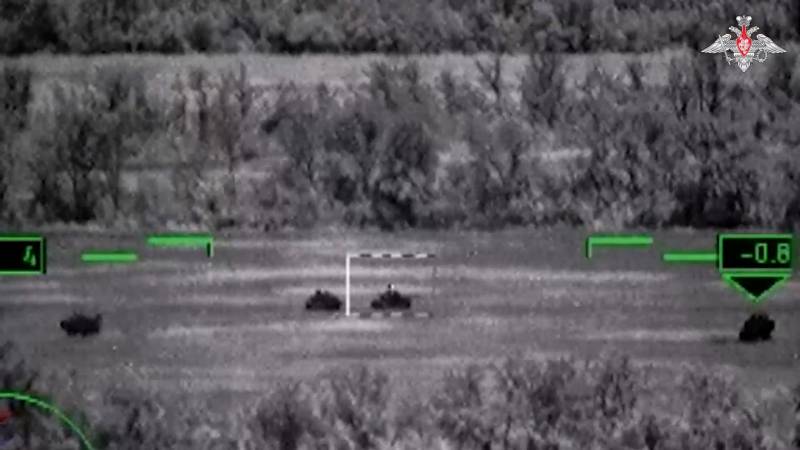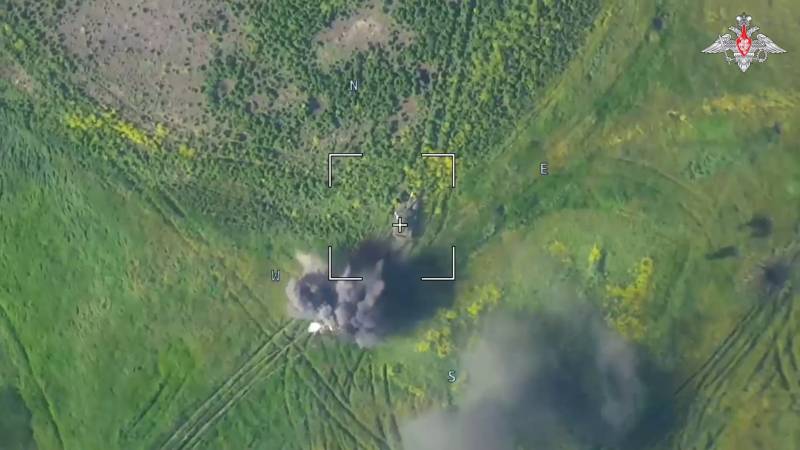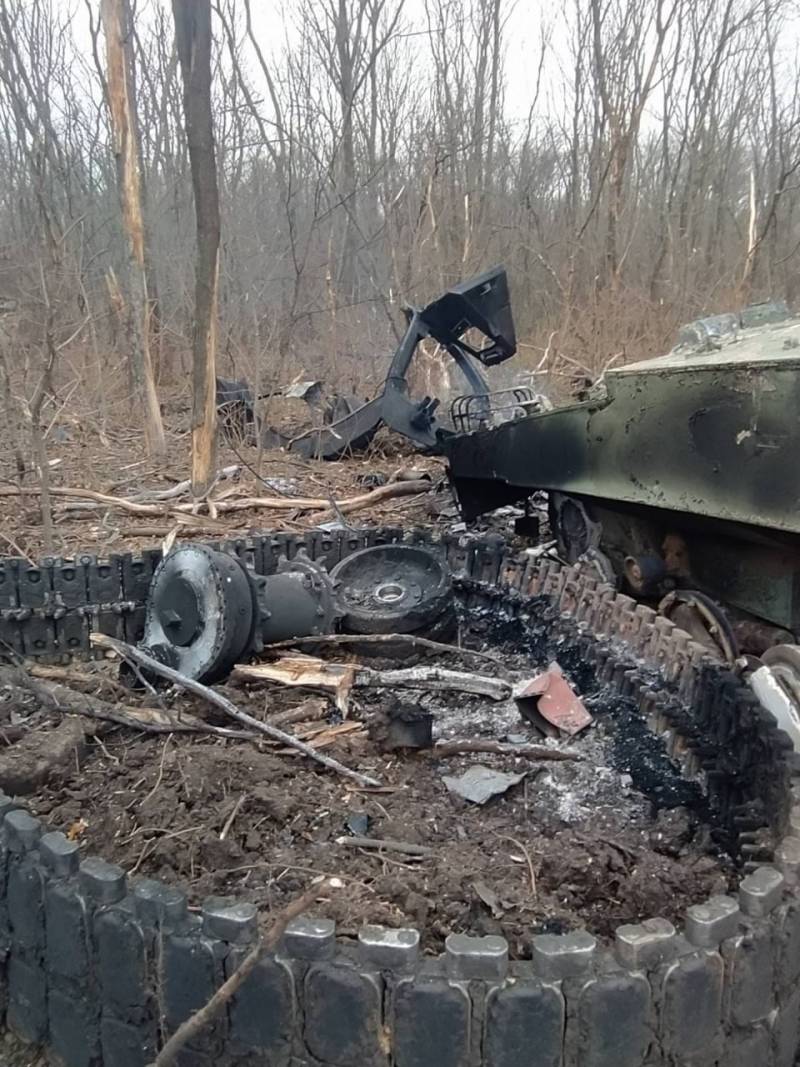Written off, handed over and lost: the negative consequences of aid to Ukraine for NATO countries

Ukrainian foreign-made armored vehicles in the sights of a Russian Ka-52 helicopter. Photo by the Ministry of Defense of the Russian Federation
NATO countries have been providing the Kyiv regime with active military-technical assistance for a long time and actually support it in this regard. Regularly and in significant quantities, equipment, weapons and ammunition of various classes and types are sent to Ukraine for use against the Russian army. At the same time, the vast majority of such deliveries are carried out by disarming our own units and / or emptying warehouses. Another problem is the extremely low efficiency of foreign weapons in the hands of Ukrainian forces. All this can have serious economic, political and military consequences.
Written off and transferred
Programs of military, technical and economic support for Ukraine are costly for NATO countries, primarily the United States. Just a few months ago, their total spending in this context exceeded $100 billion. Other countries of the Alliance have allocated smaller amounts, but the share of such costs in their budget may be much higher. At the same time, NATO does not plan to stop, and therefore it should be expected that the costs of individual countries and the organization as a whole will continue to grow.
The main direction of support for the Kyiv regime is the supply of military products, primarily from the presence of its own armies. As a result of these processes, the fleets and arsenals of NATO countries have been noticeably reduced, and the continuation of deliveries will lead to the continuation of this trend. At the same time, replenishment of such “losses” takes time and money.
Curious statistics on deliveries and their impact on the state of foreign armies was recently published by the well-known resource LostArmour. Based on open data, its authors calculated what the parks and arsenals of foreign armies were like, how much materiel was transferred to Ukraine, and what share it was. By now, this information is partly outdated, but the main trends remain the same.

Destruction of Soviet-style equipment. Photo by the Ministry of Defense of the Russian Federation
So, in the recent past, NATO countries had a total of more than 8,8 thousand people. tanks. Ukraine was given approx. 480 cars - about 5% of the total. The fleet of NATO infantry fighting vehicles has been reduced by more than 500 vehicles or approx. 4%. Out of 23,6 thousand armored personnel carriers, 1 thousand were given away - approx. 4%.
Self-propelled artillery in the amount of 3,95 thousand units. reduced by the same 4%. The number of towed systems with a caliber of less than 122 mm and mortars transferred to NATO was reduced by only 300 units, and this amounted to only 2% of the total. For towed guns with a caliber of more than 122 mm, a record share of 8% was achieved (260 units out of 3,25 thousand). The transferred rocket artillery in the form of 84 MLRS is 5%. At the level of 8% of its own fleet, anti-aircraft missile systems were allocated, with the exception of portable ones.
It is noteworthy that the shares of "losses" of different countries differ greatly. Thus, the United States, despite all the promises, has not yet sent its tanks to Ukraine. At the same time, Poland decommissioned and transferred 41% of its MBTs. Individual countries, such as the Czech Republic or Slovenia, have shipped as many tanks as the active fleet. You should also remember Denmark, which gave Kyiv all its self-propelled guns, incl. already ordered but not yet received.
Attention should be paid to how the composition of foreign aid packages has changed. At first, Western European countries and the United States removed from service or storage only infantry weapons. Then the Eastern European states began to send equipment and other Soviet-style equipment to Kyiv. They began to switch to weapons and armored vehicles of NATO standards later.

A moment before the tank was hit by loitering ammunition, filming from an attacking UAV. Photo by the Ministry of Defense of the Russian Federation
The United States and NATO intend to continue military-technical support for the Kyiv regime. New deliveries of this or that materiel are expected, both already announced and just planned. In addition, they talk about a fundamental expansion of the product range. In particular, the transfer of NATO aircraft is expected. As before, the main part of such deliveries will be carried out at the expense of the disarmament of foreign armies. The share of specially manufactured products will remain small.
Tainted reputation
The Russian army is successfully continuing the forced demilitarization of Ukraine. In the first weeks and months of this process, the overwhelming majority of the materiel that Kyiv inherited during the collapse of the USSR and received in recent years was destroyed. Then the process of destroying Soviet-style equipment and weapons, transferred in the first aid packages, began.
To date, the old materiel, both available and received from abroad, has suffered critical losses. One of the reasons for this was its moral and physical obsolescence. T-72 tanks of old modifications, MiG-29 aircraft of early versions, etc., the use of which was ensured by no less old means, actually had no chance against modern Russian weapons.
Foreign patrons assumed that the newer NATO-style equipment could make a difference, but these hopes did not materialize. So, modern M777 towed guns, with all the advantages, have retained all the inherent disadvantages of non-self-propelled systems. Corrected missiles of foreign MLRS / HIMARS MLRS turned out to be an easy target for Russian air defense.

The defeat of the Finnish armored personnel carrier XA-180. Photo UNM DNR
In recent weeks, the confrontation between Russian and NATO weapons has manifested itself especially clearly. So, with the help of modern strike weapons, modern Patriot, NASAMS or IRIS-T air defense systems were disabled or destroyed, and some of them actually had no chance of salvation. Of particular interest are the recent losses of German Leopard 2 tanks of current modifications and American BMP M2 Bradley. Together with combat vehicles, the enemy lost a significant part of engineering equipment from the fire of the Russian army.
The loss of modern NATO materiel can no longer be explained by obsolescence. Leopard 2s or Patriots are actively marketed as modern and efficient models, and such an explanation will hit their commercial potential. However, from this point of view, destruction on the battlefield is also a blow, which, moreover, becomes an advertisement for Russian systems and complexes.
In the near future, the United States promises to transfer its M1 Abrams tanks to Ukraine. After the failed debut of the German Leopard 2, such a move looks ambiguous. Several foreign countries are going to supply F-16 fighter jets. There is every reason to believe that such assistance will also turn out to be useless, and these aircraft will add to the already considerable list of losses of the Ukrainian Air Force.
Big politics
For a long time, fears have been expressed about the possible military intervention of NATO in current events. It is assumed that against the backdrop of the collapse of the Kyiv regime, the Alliance may enter into an open conflict with Russia. However, the events and processes observed now show that foreign countries should not do this - such steps can have the most serious consequences.

Broken self-propelled guns AHS Krab. Photo Lostarmour.info
According to open information, to date, NATO countries have given Ukraine no more than 4-5 percent. from the total number of their tanks, armored personnel carriers, infantry fighting vehicles, self-propelled guns, guns, aviation technology, etc. The vast majority of materiel remains in service or in storage. However, the quantitative indicators of the armies should not be directly translated into qualitative ones and, on their basis, the military potential of the Alliance should be assessed.
During the preparation of assistance packages for the Kyiv regime, it turned out that in a number of countries the state of parks and arsenals leaves much to be desired. A limited number of equipment and weapons were in active operation, and a significant part of them required repair. In addition, not in all cases we are talking about modern samples, regardless of the country of their production.
In recent weeks and months, the Russian army has clearly shown that it can counteract foreign materiel, fight it and successfully destroy it. Even the most perfect and advertised samples were not an exception.
Under such conditions, it will be quite difficult to recruit a full-fledged grouping of troops for an effective confrontation with the Russian army, even with the forces of a large number of countries. In addition, the potential of such a grouping, which, as it turned out, is not equipped with the most effective weapons and equipment, is a big question. It will be extremely difficult for her to resist the Russian army, which has modern materiel and combat experience, incl. experience in dealing with foreign models and tactics.

A well-known episode - an attempt at a "counterattack" ended in a rout. Photo by the Ministry of Defense of the Russian Federation
Successive demilitarization
To date, the Russian armed forces have almost completely destroyed the military potential, parks and arsenals of the Ukrainian formations mod. 2021-22 In addition, great damage was done to the enemy's military infrastructure. Now the Kiev regime is actually on the payroll of foreign partners, and its capabilities are determined mainly by their help and supplies.
NATO countries have by now sent several percent of their equipment and weapons of various classes to Ukraine. A significant part of this aid has already been destroyed, and such processes are successfully continuing. This means that Kyiv needs new aid packages with a variety of materiel, otherwise it will lose all possibility of resistance.
The United States and NATO as a whole are ready to continue supplying Ukrainian formations and even expand the range of supplies. However, now such assistance will lead to a reduction in the Alliance's own potential. Moreover, some of its members are already left without certain types of equipment.
Thus, the demilitarization of Ukraine turned into the disarmament and neutralization of the NATO bloc. Given his plans for Russia and regular aggressive steps, such processes cannot be called negative. According to their results, the Alliance may face a serious failure in combat capability. It is possible that this will force him to moderate his ambitions, at least for a while.
Information